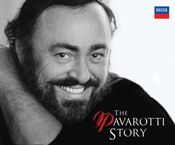Both tenors were blessed with distinctive, appealing instruments, and if the inclination might be to find Pavarotti’s voice more beautiful, Domingo often got the credit for being the more dramatic, impassioned performer.
 Decca’s The Pavarotti Story covers the singer’s career amply, with one disc dedicated to his studio recordings of the great tenor arias, another full of Italian song and such sacred favorites as the Bach/Gounod “Ave Maria.” Two “bonus” discs fill out the set; one is a 37 minute interview with a John Tolansky, whose obsequious style can be deduced from the first track quotation, “Luciano Pavarotti, you have been a legend in your lifetime…” The second bonus disc begins with the first 5 recordings Pavarotti made in a studio, released on an EP in 1964 (Decca had already released these tracks on the earlier compilation, “For Lovers Only.”) That disc is comprised of tracks, mostly duets, that don’t do Pavarotti’s “legend” much credit. The “Pearlfishers” duet with Nicolai Ghiaurov should have been a winner, but the slow pacing makes for a lugubrious tone. “Nessun dorma!” with Carreras and Domingo, from the first “Three Tenors” affair, becomes a scream fest. And better to pass over the tracks with U2, Elton John, and even Frank Sinatra (at the end of his career) in silence.
Decca’s The Pavarotti Story covers the singer’s career amply, with one disc dedicated to his studio recordings of the great tenor arias, another full of Italian song and such sacred favorites as the Bach/Gounod “Ave Maria.” Two “bonus” discs fill out the set; one is a 37 minute interview with a John Tolansky, whose obsequious style can be deduced from the first track quotation, “Luciano Pavarotti, you have been a legend in your lifetime…” The second bonus disc begins with the first 5 recordings Pavarotti made in a studio, released on an EP in 1964 (Decca had already released these tracks on the earlier compilation, “For Lovers Only.”) That disc is comprised of tracks, mostly duets, that don’t do Pavarotti’s “legend” much credit. The “Pearlfishers” duet with Nicolai Ghiaurov should have been a winner, but the slow pacing makes for a lugubrious tone. “Nessun dorma!” with Carreras and Domingo, from the first “Three Tenors” affair, becomes a scream fest. And better to pass over the tracks with U2, Elton John, and even Frank Sinatra (at the end of his career) in silence.
Ah but the first two “non-bonus” discs confirm the legend. In Bellini and Donizetti, the voice has a delectable sweetness, whether punching out the high C’s in the Fille du Regiment aria or silkily spinning out the long legato lines of “A te o cara.” The Puccini arias have a sensuous masculinity; the Verdi selections showcase Pavarotti’s beefier side (including a credible “Nium mi tema.” And those who fall asleep in Idomeneo need to listen to the gorgeous, detailed “Fuor del mar.”
True, the arrangements on the songs disc get a bit tacky (especially those with Henry Mancini), but no one will ever quite spin through Rossini’s “La Danza” as Pav did, or make “O sole mio” sound so fresh again.
The set comes with one lavish booklet with a biography and track notes, and another with a full discography.
Domingo’s disc, Pasión Española, presents 13 selections in a popular Spanish song form called “copla,” according to the booklet essay. Although the disc credits 5 composers, no distinctive voice emerges. Most of the tracks feature extensive instrumental introductions, with many a familiar gesture of rhythm and melody, like a cartoon setting up a Spanish locale. The lyrics tend to trite expressions of frustrated or ecstatic love, and much bitter jealousy.
A whole disc of coplas, in other words, goes a long way. But if listeners were to hear a track or two individually, they might well be caught up in the conviction Domingo brings to the project. No, he doesn’t sound like a young man, but age seems to have only deepened the bourbon-hue of his tenor (often called “baritonal”), and for sheer vocal production Domingo makes the disc enjoyable.
Miguel Roa and the Orquesta de la Communidad de Madrid provide the professional accompaniment.
If somehow an opera lover needs one set of Pavarotti at his best, they can be satisfied with either “For Lovers Only” or this “The Pavarotti Story.” For all but his most devoted fans, there are better recordings in the Domingo library to enjoy than Pasión Española.
Chris Mullins

